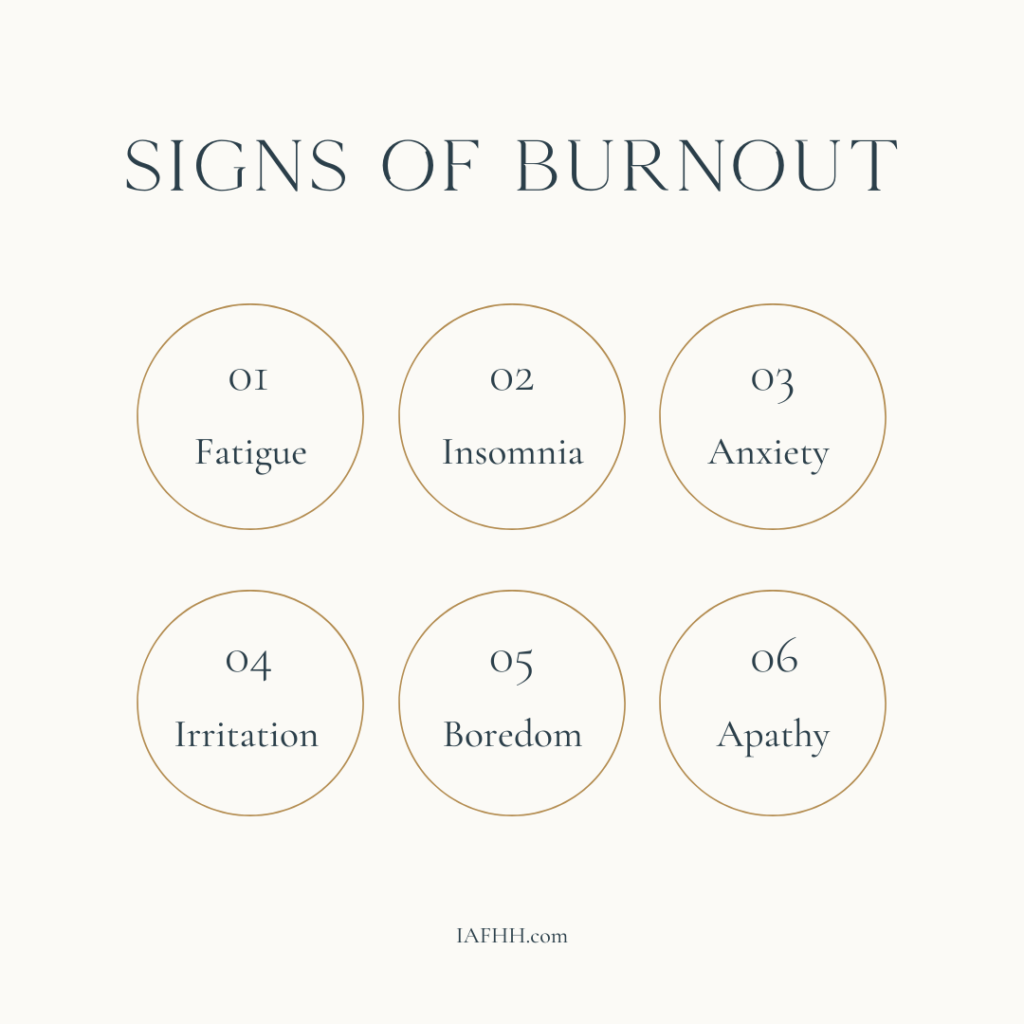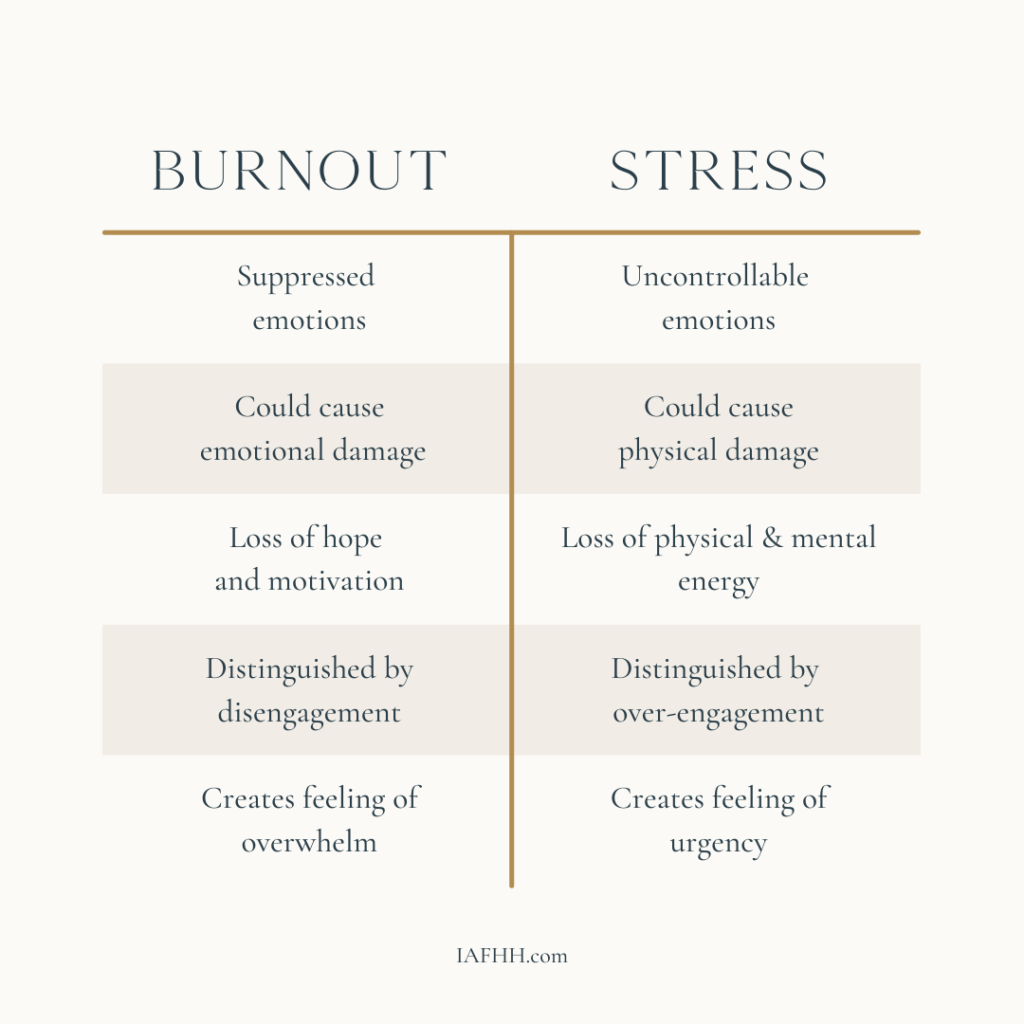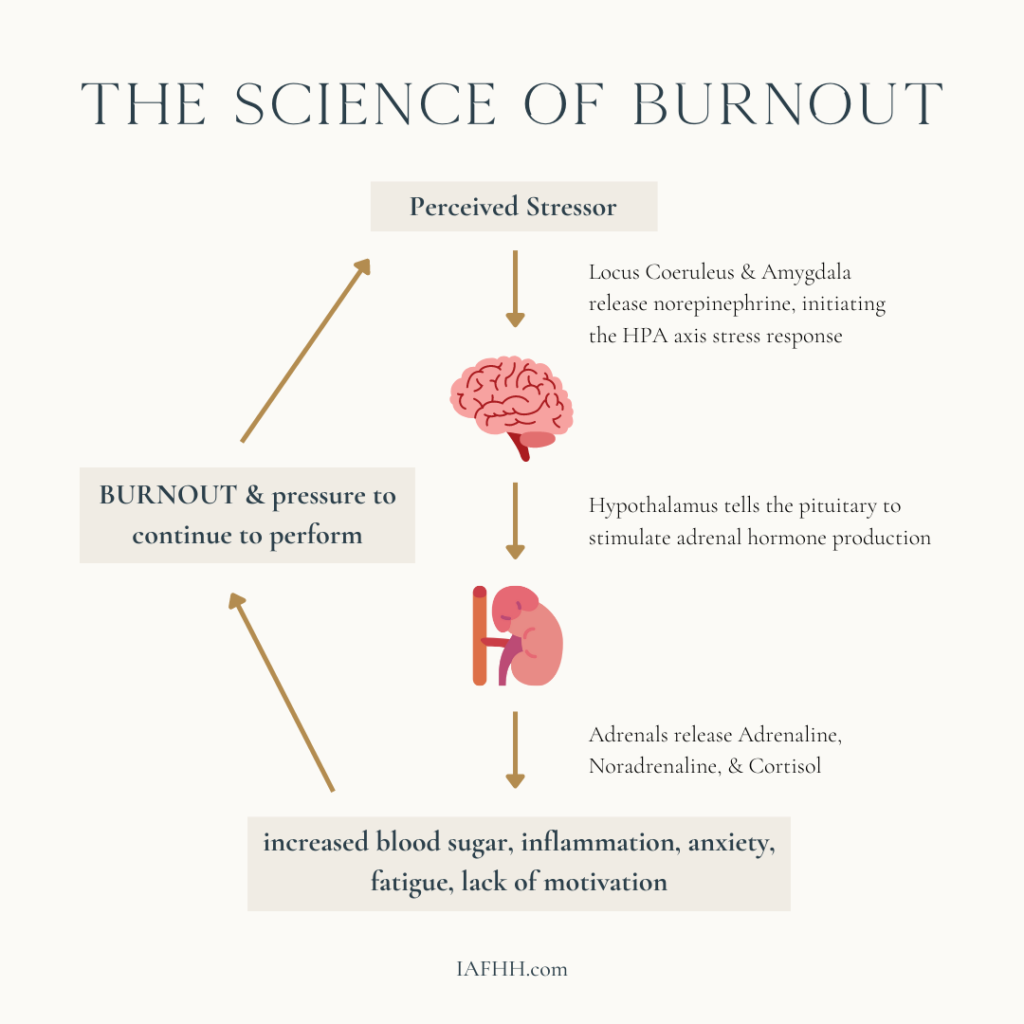Are you frustrated by the simplistic recommendations of “getting more sleep” and “decreasing your stress” when it comes to addressing burnout and want to learn more about why burnout happens and how to prevent it?
In this article, you’re going to learn the science behind why burnout happens, including what happens physiologically in the body when we are “burnt out”, and how you can prevent burnout altogether so you can step out of the stress and into success in your practice.
What is Burnout?
Burnout is the result of chronic overwhelm and exhaustion due to a combination of being overworked, underpaid, under-appreciated, and/or unfulfilled.
If not identified and managed appropriately, burnout can affect us physically, emotionally, and mentally. This can make us feel symptoms of fatigue, insomnia, anxiety, irritation, boredom, apathy, dissatisfaction, resentment, and depression.

Although burnout is a common disturbance amongst many entrepreneurs, that doesn’t mean you have to be victim to it as well!
When you are aware of the primary symptoms and reasons why burnout happens, you can take proper action to prevent it from overtaking your practice and inhibiting you from achieving the success you deserve.
The Difference Between Stress and Burnout
Stress happens to everyone. Of course, different levels of stress can inflict our lives, and everyone has a different tolerance to how much they can handle at once. Although, at the root, stress is just an inevitable part of being a human.
Whereas burnout, although triggered by stress, often feels like so much more. It feels like the weight of the world on your shoulders, plus a lack of energy and motivation to fix it.
When we get to the point of burnout, many people find themselves feeling completely overwhelmed, exhausted, and unsatisfied with what they’re doing. It’s often accompanied by feelings of confusion, frustration, loss of hope & motivation, disengagement, and suppressed emotions.
Once we reach burnout it’s usually a sign that stress has been present for quite some time.

When we reach burnout, it means there are chronic underlying imbalances (both physical & emotional) caused by too much hustle and overwhelm. This can be due to a lack of functional systems and boundaries within your business.
When we’re stressed, we may feel temporarily overwhelmed, anxious, and frustrated. But if we don’t take the time to set up functional systems & boundaries to reduce the stress… that’s what will lead to burnout.
Burnout is different from stress because it’s chronic.
The Science of Why Burnout Happens
On a physiological level, when your brain perceives stress (whether emotional or physical), it initiates the HPA-Axis (Hypothalamic-Pituitary-Adrenal Axis) stress response.

In response to stress, the Hypothalamus signals to the Pituitary to tell the Adrenals to produce Adrenaline, Noradrenaline, and Cortisol.
These hormones stimulate the fight-or-flight response, increasing heart rate, dilating blood vessels, and releasing sugar from the liver, muscles, and peripheral tissues for quick energy needed to fight or flee the situation.
The problem is that cortisol tends to hang around for a bit even after the initial stress has been mitigated. The initial role of cortisol within the stress response is to be anti-inflammatory and protective, helping to clean up the damages that stress has caused to the body. However, in times of chronic stress, this can lead to the opposite effect.
When cortisol production is consistent due to chronic stress, this can eventually lead to increased inflammation, dysregulated blood sugar, decreased immunity, chronic catabolism, decreased muscle mass, and decreased pain tolerance. (1) Not to mention an increase in anxiety, depression, fatigue, and lack of motivation. A true recipe for burnout!
How Burnout Can Affect Your Practice
When it comes to running a private practice, there’s a lot to handle at once. Between the constant pressure to give the best support possible to your clients, to keep up with the newest research, data, and methodologies, as well as staying consistent with your marketing, email maintenance, accounting, admin work, etc., there’s a lot to work with! As you can imagine, each one of these things can be considered a stressor, and over time they add up!
So if you aren’t able to recognize where these stressors are infiltrating into your practice, business, and life, and then you don’t take time to rest, set firm work-life boundaries, and let go of perfectionism, your flame is inevitably going to burn out. It’s simple physiology!
How to Prevent Burnout in Your Practice
Stress in life and business is inevitable. However, if not identified and managed properly, the physiological impact it can have on the body can affect us in many areas of our lives and business. Although we may not be able to prevent all forms of stress, there are plenty of things we can do to support our bodies and minds to prevent it from turning into burnout.
1. Honor your boundaries
Even though your business may require you to hustle, multi-task, and manage a lot of moving pieces, you still have to take time to rest.
If you haven’t yet set firm work hours for your business, do that now. Set those hours today and stick with them.
If you’re not taking 1-2 days off a week to unplug and enjoy your life, make a commitment today to set that boundary.
Trust me, if you don’t take time out for yourself, set these boundaries, and learn to say no when necessary, you’ll become a victim of burnout in no time. Don’t let that happen! Your happiness, your business, and your clients are way too valuable.
Take care of your needs first so you can show up 100% and as your best self for your community & clients. They deserve that, and so do you.
2. Double down on what you love & let go of what isn’t working
Your business is your playing ground, and there are so many routes you can take to achieve the success you’re wanting.
So if you’ve been beating your head against the wall trying to stay consistent with something you despise doing (for example, writing blog posts if you hate writing) ⏤ then it’s time to make a change.
Instead of “doing what everyone else is doing” just because it worked for them, I challenge you to think about all the things you love doing in your business and double down on those aspects.
For example, if you love writing and you find it’s a great way to express thoughts, feelings, and emotions in a healthy way that also provides value to your community ⏤ keep it up. Your followers will feel that intention and soak up every bit of it.
On the other hand, if writing is a sore spot for you, takes up too much of your time, and doesn’t bring you followers, engagement, or clients. Let it go.
It’s time to get real with yourself. Identify what works and what doesn’t, and create systems that light you up instead of burning out your flame.
3. Learn how to let go and outsource tasks
As you probably know, running a business and private practice requires a lot of moving pieces. Not only are you the primary practitioner, but you’re also the marketing strategist, content designer, copywriter, customer service representative, administrative support, accountant, and so much more.
As you grow your business to new levels and start taking on more clients or bigger projects, you may eventually reach a point where it just becomes too much.
Outsourcing can be a great way to take a load off your plate so that you can dial in your expertise where it shines the most.
Not sure where to start or what to outsource? Think about what we discussed in the last bullet point. I encourage you to sit down and brainstorm what tasks and jobs in your business you love versus what you don’t enjoy doing. You’ll also want to consider what it is that you may be good at, or even enjoy, but that ultimately take up too much of your time.
Depending on what areas of your business you don’t enjoy, or don’t have time for, those are the tasks you’ll want to outsource.
Check out Fiverr or Upwork as great options for seeking virtual assistance support for a myriad of tasks and projects.
4. Let go of the perfectionism and take messy action
Do you ever find yourself feeling confused, scared, or intimidated about how to show up in your business consistently and effectively?
I think at some point most of us do, especially when we’re starting something new, like dabbling in Instagram reels or stories, showing up live for a presentation, or a new client package.
But the truth is, we all have to start somewhere. No growth comes from our comfort zone.
Even if you don’t have a plan, show up anyway, and take messy action until the vision becomes more clear.
Even if you’re afraid, lean into that and challenge yourself to embody those fears. You may be surprised to learn that they are your deepest strengths just waiting to be untapped!
Let go of needing things to be “perfect” or the fear of something being a bust. When you have faith in not only the process but yourself as well, only good things will come.
5. Collaborate with colleagues
It’s no doubt that monotony can make just about anyone go insane with time.
One of my favorite ways to keep things fresh, tap into new opportunities, and expand my network is to collaborate with others.
When seeking collaborative opportunities, try to find people/brands who are aligned with your work and have similar audiences (rather than with people who are doing the exact same things as you).
For example, if you are a Nutritionist, try reaching out to some Fertility Awareness Educators, or Mindset/Movement coaches to collaborate with.
Not only are you able to tap into each other’s communities, but your followers/clients also get the chance to expand their network and potential resources for support.
This provides your community with extra value, while also making your experience as an entrepreneur more fun, exciting, and expansive.
6. Support Your HPA-Axis
We can take action to avoid burnout by taking the workload off of our plate, leaning into areas of business that light us up, and taking time to rest… but we also have to understand that stress and burnout have just as much of a physiological impact as it does a mental/emotional one.
Supporting the body and brain physically during times of stress, or even as a preventative measure, can do wonders in expanding one’s stress resiliency and decreasing the risk of reaching burnout.
As we discussed earlier, two primary areas where stress impacts us physiologically are within the brain and the adrenals. By supporting the HPA-Axis in this way, we can help our bodies to adapt more easily to incoming stressors and experiences.
HPA-Axis Support:
- Adaptogenic Herbs: These are herbs that support adrenal function and stress resiliency by promoting a healthy response to stress through modulating the production and impact of stress hormones on the central nervous system. (2) Adaptogenic herbs have different properties. It would be best to seek counsel from a qualified practitioner as well as your primary physician before introducing herbs into your diet.
Adaptogenic herbs to consider for stress support:- Ashwagandha
- Tulsi Holy Basil
- Eleuthero
- Rhodiola
- Schisandra Berry
- Reishi Mushroom
- Maca Root
- Vitamin C: One of the primary nutrients that support adrenal function and stress resiliency is vitamin C from whole food sources such as citrus fruit, amla, camu camu, and rosehips. (3)
- Morning Sunlight: The adrenals play a role in the body’s cortisol awakening response, which is supported by exposure to sunlight upon waking. Ideally one should subject themselves to morning light immediately upon waking, or at least within the first 30 minutes. This can be achieved by going outside and allowing the sun to hit one’s face, opening the blinds/curtains fully when getting ready, or utilizing a Lightbox with at least 10,000 lux.
- Phosphatidylserine: This phospholipid is integral to cell membrane health & function that can support the hypothalamus in response to excess cortisol levels from chronic stress. (4) Within the brain, Phosphatidylserine can promote neurotransmitter utilization and metabolism, prevent neuronal degeneration, and promote myelin sheath repair. (5) It is ideal to it take first thing in the morning and right before bed.
Looking for more resources?
Want to learn more about the physiology behind stress and how to set your practice up for success so you can avoid burnout? Be sure to check out our practitioner training, the IAFHH Functional Hormone Specialist Certification Program.
By receiving the cutting-edge research and specialized education available in our program, you will quickly excel in your private practice and become the go-to hormone health expert in your community. In this program, we support you with all the tools, resources & information you need to expand your expertise in functional hormone health, get your female clients to achieve real & lasting results, and excel in your women’s health practice.

About the Author
Ashe Milkovic, NTP, IC-FHS, FBCS
Ashe is the founder and CEO of The International Association for Functional Hormone Health. She has a passion for spreading awareness about the power of functional nutrition for optimizing hormones & fertility, and her mission is to build community and safe space for other practitioners and aspiring learners to expand their knowledge and expertise in functional hormone health.
Article Sources:
- Hannibal KE, Bishop MD. Chronic stress, cortisol dysfunction, and pain: a psychoneuroendocrine rationale for stress management in pain rehabilitation. Phys Ther. 2014 Dec;94(12):1816-25. doi: 10.2522/ptj.20130597. Epub 2014 Jul 17. PMID: 25035267; PMCID: PMC4263906.
- Panossian A, Wikman G. Effects of Adaptogens on the Central Nervous System and the Molecular Mechanisms Associated with Their Stress-Protective Activity. Pharmaceuticals (Basel). 2010 Jan 19;3(1):188-224. doi: 10.3390/ph3010188. PMID: 27713248; PMCID: PMC3991026.
- Das D, Sen C, Goswami A. Effect of Vitamin C on adrenal suppression by etomidate induction in patients undergoing cardiac surgery: A randomized controlled trial. Ann Card Anaesth. 2016 Jul-Sep;19(3):410-7. doi: 10.4103/0971-9784.185522. PMID: 27397444; PMCID: PMC4971968.
- Hellhammer J, Fries E, Buss C, Engert V, Tuch A, Rutenberg D, Hellhammer D. Effects of soy lecithin phosphatidic acid and phosphatidylserine complex (PAS) on the endocrine and psychological responses to mental stress. Stress. 2004 Jun;7(2):119-26. doi: 10.1080/10253890410001728379. PMID: 15512856.
- Glade MJ, Smith K. Phosphatidylserine and the human brain. Nutrition. 2015 Jun;31(6):781-6. doi: 10.1016/j.nut.2014.10.014. Epub 2014 Nov 4. PMID: 25933483.
